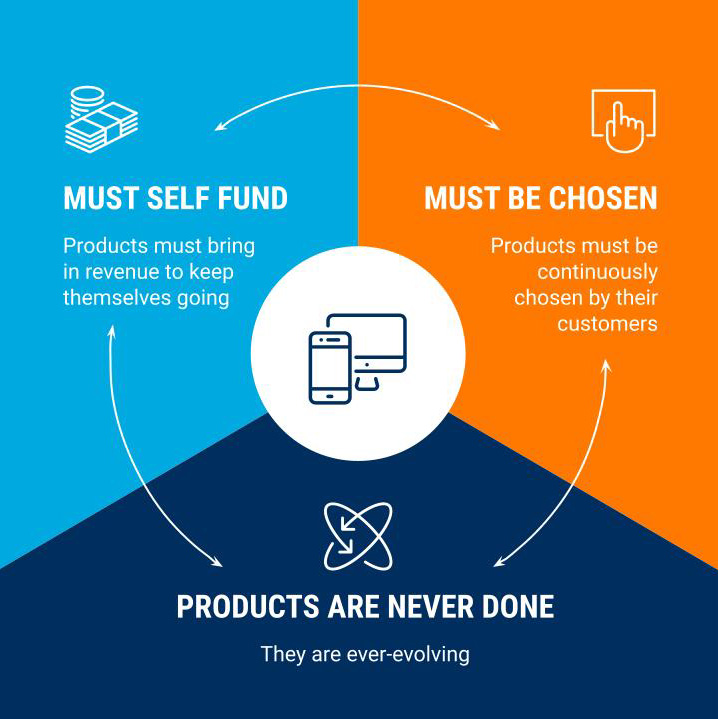
What is a software product?
Software products have become an inextricable part of the fabric of modern life. Without them, business would grind to a halt, and leisure time would look radically different. The majority of people interact with software products every day, multiple times a day, but would probably have a tough time defining what a software product actually is.
Scott Varho, Senior Vice President of Product Development at 3Pillar Global, offers this jumping-off point: “[A software product is] any product, service, or supplement that relies on software as a component of its core value proposition.” And part of that value proposition is that a software product is (or should be) designed to solve a real problem for real people or enterprises.
Software can be an invisible part of an experience, such as the backend software powering a platform like Netflix, or it may be more apparent, such as when you’re editing photos in Adobe Photoshop or dialing in to a Zoom call. But whatever the nature of the interaction, the most important thing about any software product is that it unlocks some kind of value for the user, which, in turn, will provide value to the company that owns that product.
Not surprisingly, creating robust software products is a complicated endeavor, and the type of software product your business may need will depend on the use case. That said, Agile and other iterative methodologies provide a framework for development that can help deliver early value for users that will allow the software creators to see ROI from an early stage.
And there’s something else to remember: A software product is made by and for real live human beings. So, while the integrity of the backend software architecture is foundational to the long term success of any product, design thinking and human-centered design on the frontend must also form the fabric of the software creation process. In fact, these two design approaches are two sides of the same coin. Design thinking is about the big picture. It asks what problems this software product will solve. Human-centered design is about the specifics of usability and asks what the experience of using this product to solve a problem will be like for real users. Iterative delivery (Agile) should always include iterative learning (Design Thinking), but this is particularly vital for software products.
This article will look at types of software products, their benefits, and some of their characteristics.
Types of Software Products
Francisco Ponce points out that there are several platforms by which software products may be distributed to end users, including desktop computers, websites, files, or services.
But wherever they are used or accessed, there are certain commonalities when it comes to these products. For one, the world is now primarily a digital economy. All products and services need to have a digital component to remain relevant or risk being marginalized by competitors that understand this fact.
In The Product Mindset, the authors explain this concept: “Today, the technology itself is the value proposition. The digital product is either the asset being purchased or the primary mechanism by which the service is delivered. Therefore, the digital economy is a product economy: powered by software and fueled by data.” In short, software products drive the modern digital economy.
Consumers and businesses will typically interact with a few main types of software products:
COTS or SaaS
COTS, or consumer off the shelf software, is a traditional model of packaged software applications available to a large audience with varying yet fundamentally similar needs. Microsoft Word, for example, is designed for the mass public as a solution to the diverse needs of its users. COTS are generally on-premise (or offline) solutions with a one-time purchase price. SaaS, or software-as-a-service products, are exclusively cloud-based and usually offered as monthly or annual subscription services. Unlike COTS, SaaS products don’t need to be installed directly onto a computer or laptop, and updates happen automatically, requiring no action on the part of the user. Salesforce was a pioneer in the realm of enterprise SaaS solutions. While they aren’t bespoke, COTS products usually require some level of configuration and SaaS products often allow for some degree of customization from already-existing features—depending on need and price tier.
Customized
Customized software development entails the commissioning, design, development, release, and maintenance of a software product tailored to a single business or commercial entity. It provides tailor-made, bespoke features and functionality that off-the-shelf software doesn’t and solves unique problems specific to a particular audience.
Because custom software is designed for different use cases, which vary by industry, market segment, and buyer/user personas identified in conjunction with the business goals and strategy, it can help certain users excel in ways that COTS or SaaS simply cannot. McDonald’s, for example, employs customized POS (point of sale) technology in its self-serve kiosks. Uber’s proprietary software disrupted the ride-hailing industry, and Google became the leading Internet search engine with the help of its own customized software. This kind of success only happens when companies listen to their market segment to understand their unique problems and then ideate ways to solve them. And that’s just the tip of the iceberg; most of the apps you interact with regularly are probably built on custom software.
Characteristics of Computer Software Products
Of course, software products need to function well to fulfill their main purpose of delivering value to the end user. In a well-made product, both the backend (the logic and data persistence) and the front end (the User Interface/User Experience) should share some key characteristics:
- Efficiency: The software should optimize processes for both the machines and the humans working with those machines.
- Maintainability: Bugs and issues should be spotted and resolved rapidly so that users don’t experience annoying work interruptions.
- Dependability: Well-built software should be reliable, secure, and compliant with privacy and security conventions.
- Functionality: Software should perform all the functions it is supposed to perform to maximize the user experience and deliver the promised value.
- Adaptability: The software system should have the ability to be adapted, within reason, to changing user requirements.
If a software product doesn’t solve a real problem that people would be willing to pay for, then it’s not going to succeed—no matter how well it’s built. Moreover, even if a product does solve a need, if the experience of interacting with that product isn’t intuitive, then people probably aren’t going to want to use it.
Here, “well built” refers both to the backend code and to the frontend user experience. Optimizing this experience begins with empathy. In practice, it means seeking to understand the customer journey by doing user research and then mapping those journeys to the actual software products via robust UX designs. Iterative processes, such as Agile, facilitate the creation of well-engineered, intuitive software products.
Benefits of Software Products
As we’ve seen, software products should provide benefits to the users first. In turn, it will translate into benefits for an organization. And to create this value for an organization, software products should solve specific problems for users. To that end, software products should:
- Offer an exclusive solution, or solve a problem in a much better way than other products do
- Offer a competitive edge by clearly differentiating from the crowd
- Minimize time to value by putting the smallest solution to the largest problem in the hands of users.
- Solve for real-world needs while anticipating the needs of the future
- Excel at change by knowing when to pivot and how to do so rapidly and with ease
How We at 3Pillar Define a Software Product
- Self-funding: A successful product generates revenue and support that fuels the business and justifies further investment
- Never finished: Customer needs change, markets and regulations change, and new competitors appear all the time. Successful products stay ahead of the change.
- Are chosen: Success requires that someone choose your product, use it, share it, and keep using it as new competitors enter the market and new customer problems emerge.

Conclusion
In the end, software is a process as much as it is a product. Aline Perde, Technical Manager at 3Pillar, explains: “A software product means business, roadmap, process, strategy, design, development, maintenance, testing and communication. It’s every single one of these items together, and it can never be done without people.”
To put that another way, while the process of engineering software products encompasses multiple approaches, steps, and areas of expertise, you’ll never create a successful product if you don’t have the right team who understands how to solve a real-world problem with an intuitive product that people will want to use.
To learn more about 3Pillar’s services and how we can help you create software products that solve real problems, contact an expert today.
Special thanks to these members of FORCE, 3Pillar’s expert network, for their contributions to this article.
FORCE is 3Pillar Global’s Thought Leadership Team comprised of technologists and industry experts offering their knowledge on important trends and topics in digital product development.
Recent blog posts

Stay in Touch
Keep your competitive edge – subscribe to our newsletter for updates on emerging software engineering, data and AI, and cloud technology trends.

 Angel Almada
Angel Almada

